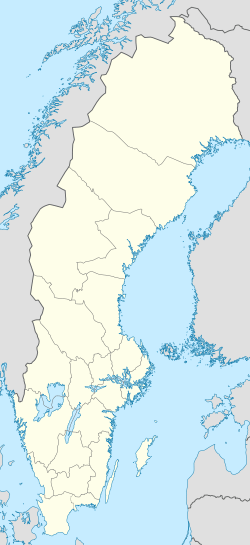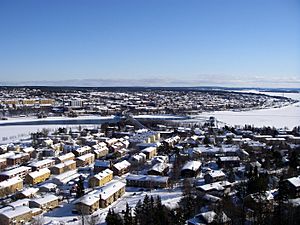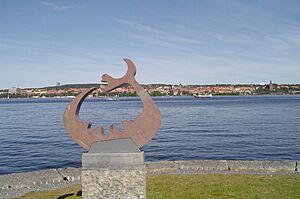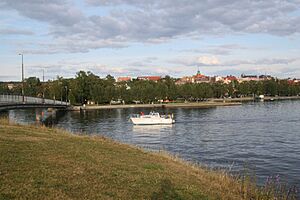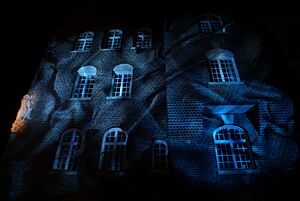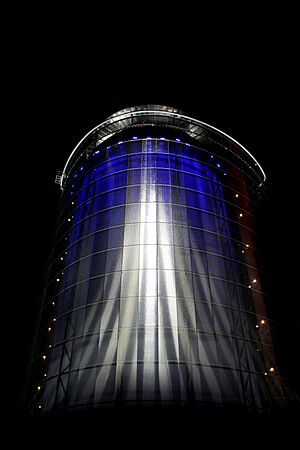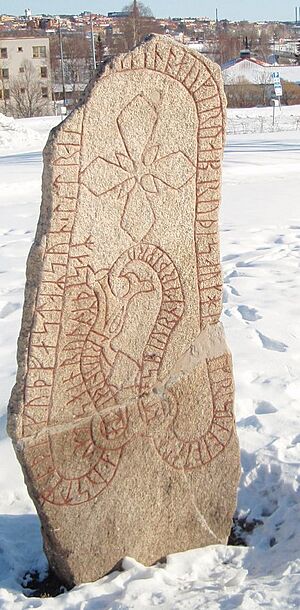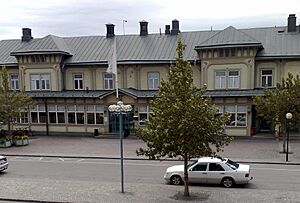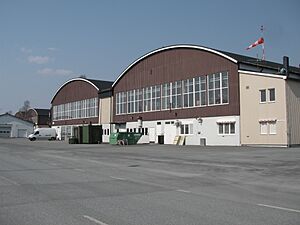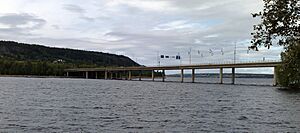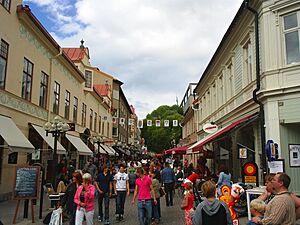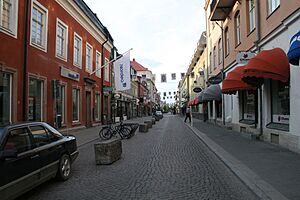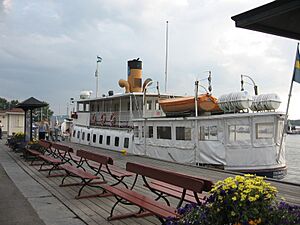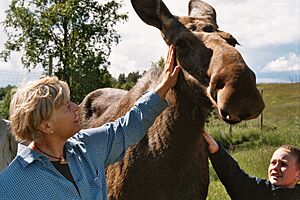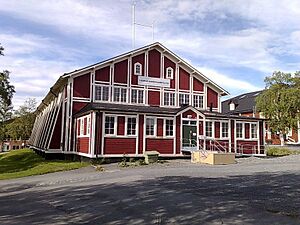Östersund facts for kids
Quick facts for kids
Östersund
Staare
|
|||
|---|---|---|---|
|
City
|
|||
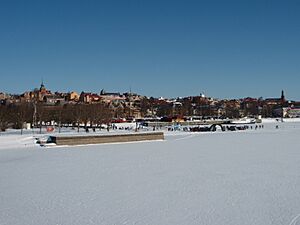
Lakeside view of Östersund in March 2008
|
|||
|
|||
| Nickname(s):
Centre of Sweden
|
|||
| Motto(s):
Vinterstaden
(Winter City) |
|||
| Country | Sweden | ||
| Province | Jämtland | ||
| County | Jämtland County | ||
| Municipality | Östersund Municipality and Krokom Municipality |
||
| Became town | 23 October 1786 | ||
| Area | |||
| • City | 27.28 km2 (10.53 sq mi) | ||
| • Metro | 2,220.50 km2 (857.34 sq mi) | ||
| Elevation | 312 m (1,024 ft) | ||
| Population
(31 December 2015)
|
|||
| • City | 49,806 | ||
| • Density | 1,625/km2 (4,210/sq mi) | ||
| • Metro | 76,410 | ||
| Demonym(s) | Östersundare | ||
| Time zone | UTC+1 (CET) | ||
| • Summer (DST) | UTC+2 (CEST) | ||
| Postal code |
831 xx
|
||
| Area code(s) | (+46) 63 | ||
Östersund (pronounced "O-ster-soond") is a city in northern Sweden. It's located in Jämtland county, right by the large lake Storsjön. Across the lake is the island of Frösön. Östersund is the only city in the Jämtland province.
This city is a key place for culture and business in the region. It's also home to the biggest campus of Mid Sweden University, with about 7,000 students. With over 50,000 people, Östersund is one of Sweden's largest inland cities.
Östersund was founded in 1786. The Swedish government wanted to control trade in Jämtland. They hoped local farmers would sell their goods through Östersund. But people didn't like this idea, so the city grew slowly at first. It wasn't until the railroad arrived in the late 1800s that Östersund really started to become a busy city.
The city is in the middle of Scandinavia. It connects to Sundsvall on Sweden's east coast and Trondheim in Norway. Because it's so central, Östersund calls itself the "centre of Sweden."
Östersund is known as the "Winter City" (Vinterstaden). Even though winters are long, the weather isn't super cold for a northern city. This is because of warm winds from the Atlantic Ocean. The city is great for outdoor activities. It has a modern cross-country ski stadium and even a ski slope right in the city! Östersund has hosted many World Championships in sports like biathlon and speed skating. It has also applied to host the Winter Olympic Games several times.
Exploring Östersund's Geography
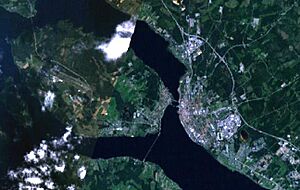
Östersund is the only city in its province. It sits on the shore of Storsjön, Sweden's fifth-largest lake. The area around the lake is called Storsjöbygden. It's known as the northernmost farming area in the world with a continental climate.
Most of Östersund, including its city center, is on the mainland. It faces the island of Frösön. For a long time, Frösön was the main hub of Jämtland. Today, many people live on the slopes of Frösön that look towards the city. A small part of Östersund is also in Krokom Municipality.
The city gets its name from the strait it spans, called Östersundet. This name means "East Sound" in Swedish.
Östersund's Climate and Weather
Östersund has a subarctic climate. This means it has long, cold winters and short, mild summers. Sometimes, cold winds from the Arctic, called "the north-westerner" or "the cold-westerner," blow into the city.
The winter weather is milder than other places at the same latitude. This is thanks to the Gulf Stream. This ocean current brings warmer winds from the Atlantic Ocean through the mountains. However, these mountains also block a lot of rain and snow. This means Östersund gets less precipitation than some other areas.
Östersund often gets a lot of sunshine. In the summer of 2007, it was the sunniest city in Sweden!
| Climate data for Åre Östersund Airport (Frösön), 2002–2020; precipitation in Tullus 2002–2020; extremes since 1901 | |||||||||||||
|---|---|---|---|---|---|---|---|---|---|---|---|---|---|
| Month | Jan | Feb | Mar | Apr | May | Jun | Jul | Aug | Sep | Oct | Nov | Dec | Year |
| Record high °C (°F) | 9.8 (49.6) |
10.3 (50.5) |
17.8 (64.0) |
20.5 (68.9) |
26.6 (79.9) |
32.0 (89.6) |
33.0 (91.4) |
31.7 (89.1) |
25.0 (77.0) |
19.7 (67.5) |
12.2 (54.0) |
10.8 (51.4) |
33.0 (91.4) |
| Mean maximum °C (°F) | 5.0 (41.0) |
4.9 (40.8) |
8.1 (46.6) |
15.0 (59.0) |
21.8 (71.2) |
24.7 (76.5) |
26.4 (79.5) |
24.6 (76.3) |
19.2 (66.6) |
12.8 (55.0) |
8.2 (46.8) |
5.9 (42.6) |
27.5 (81.5) |
| Mean daily maximum °C (°F) | −2.9 (26.8) |
−2.2 (28.0) |
1.4 (34.5) |
7.2 (45.0) |
12.6 (54.7) |
16.8 (62.2) |
19.5 (67.1) |
17.9 (64.2) |
12.8 (55.0) |
6.3 (43.3) |
1.1 (34.0) |
−1.0 (30.2) |
7.5 (45.4) |
| Daily mean °C (°F) | −5.9 (21.4) |
−5.2 (22.6) |
−2.1 (28.2) |
3.2 (37.8) |
8.2 (46.8) |
12.5 (54.5) |
15.3 (59.5) |
14.1 (57.4) |
9.8 (49.6) |
4.0 (39.2) |
−1.1 (30.0) |
−3.7 (25.3) |
4.1 (39.4) |
| Mean daily minimum °C (°F) | −8.8 (16.2) |
−8.2 (17.2) |
−5.6 (21.9) |
−0.8 (30.6) |
3.8 (38.8) |
8.2 (46.8) |
11.1 (52.0) |
10.3 (50.5) |
6.7 (44.1) |
1.6 (34.9) |
−3.3 (26.1) |
−6.3 (20.7) |
0.7 (33.3) |
| Mean minimum °C (°F) | −20.9 (−5.6) |
−20.4 (−4.7) |
−16.4 (2.5) |
−7.2 (19.0) |
−1.8 (28.8) |
2.7 (36.9) |
6.1 (43.0) |
5.0 (41.0) |
1.1 (34.0) |
−5.3 (22.5) |
−10.6 (12.9) |
−16.8 (1.8) |
−24.6 (−12.3) |
| Record low °C (°F) | −38.0 (−36.4) |
−34.6 (−30.3) |
−32.5 (−26.5) |
−22.0 (−7.6) |
−9.0 (15.8) |
−3.0 (26.6) |
−1.5 (29.3) |
−0.8 (30.6) |
−5.2 (22.6) |
−17.7 (0.1) |
−25.2 (−13.4) |
−38.1 (−36.6) |
−38.1 (−36.6) |
| Average precipitation mm (inches) | 32.1 (1.26) |
20.6 (0.81) |
22.2 (0.87) |
23.0 (0.91) |
48.1 (1.89) |
62.3 (2.45) |
76.3 (3.00) |
80.9 (3.19) |
55.1 (2.17) |
44.1 (1.74) |
33.5 (1.32) |
36.0 (1.42) |
534.2 (21.03) |
| Average extreme snow depth cm (inches) | 39 (15) |
47 (19) |
46 (18) |
27 (11) |
1 (0.4) |
0 (0) |
0 (0) |
0 (0) |
0 (0) |
7 (2.8) |
17 (6.7) |
30 (12) |
56 (22) |
| Mean monthly sunshine hours | 30 | 70 | 150 | 202 | 244 | 259 | 257 | 208 | 127 | 83 | 40 | 22 | 1,692 |
| Source 1: SMHI Temperature Data | |||||||||||||
| Source 2: SMHI Precipitation | |||||||||||||
Cityscape and Architecture
Östersund's streets are laid out in a grid pattern. Roads run north to south, crossed by alleys going east to west. These alleys lead down towards Lake Storsjön. From the city center, you can see the lake, Frösön, and the snow-covered mountains. This unique layout creates "windows to the west."
The alleys are often steep, making the buildings look like they are climbing uphill. The houses were built to fit these slopes.
Östersund was planned as a green city. Its first city plan included many large green areas and parks. Important parks today include Kyrkparken, Österängsparken, and Badhusparken. Badhusparken once had a large bath house, which was later replaced by a new one where people could swim in the lake.
In the late 1800s, Östersund grew quickly. Many houses were made of wood, but stone buildings became popular in the center. These buildings often had towers, looking like old castles. In the early 1900s, stone buildings replaced many wooden ones. New styles like Jugendstil and National Romantic style also became popular.
In the 1930s, the functionalistic style appeared in the city's newer areas. By the 1940s, the city was designed more for cars. Later, efforts were made to improve sanitation, and wastewater was no longer dumped directly into the lake. Some older buildings were torn down to make way for new developments. However, citizens saved the Good Templar house from being demolished.
The buildings along Storgatan ("the large street") are very well-preserved. They show how cities looked in Sweden in the 1880s. The wooden fronts have many details, and the houses are not too tall. Next to Storgatan is Prästgatan ("the priest street"), which is Östersund's main shopping street.
Stortorget, the main town square, is one of Sweden's unique "closed squares." It was designed like a room with openings in every direction, similar to Renaissance city planning. This square has always been the city's main market. The ancient Gregorie market is held here every March. The big city festival Storsjöyran also centers around Stortorget.
City Districts and Neighborhoods
Before Östersund was founded, the area had few people. Old settlements like Odensala and Torvalla are now major city districts. Other districts on the mainland include Staden, Norr, Söder, Odenslund, Karlslund, Körfältet, Odenskog, and Lugnvik. On Frösön island, you'll find Hornsberg, Östberget, Frösödal, Mjälle, Valla, and Härke.
The central part of Östersund is called Staden ("the city"). People from nearby villages often just call Östersund "Stan." People from Östersund are called östersundare.
Famous Landmarks
Östersund's most famous landmark is the Östersund City Hall. It's 51 meters tall and has 136 rooms. It's a great example of National Romantic architecture. The bell tower looks like a traditional Jamtish onion dome. Many sculptures on the building are made from local limestone.
The city hall was designed by Frans Bertil Wallberg. It was considered one of the best examples of modern Swedish architecture at the time.
A newer landmark is Arctura, also known as "the Thermos." This large, 65-meter-tall tank stores hot water. At night, it lights up with different colors, showing things like sunrises and the Aurora Borealis (Northern Lights).
Östersund's History
The shores of Lake Storsjön have been lived on for a long time. The island of Frösön was once the main center of the region. An ancient hill fort, Mjälleborgen, was built there around 300 AD. The old Scandinavian assembly, Jamtamót, was held on Frösön. The Frösö Runestone, the world's northernmost runestone, is also on the island.
After Jämtland became part of Sweden in 1645, there were plans to build a city there. In 1786, King Gustav III of Sweden officially founded Östersund. It was built on land bought from farmers in Odensala. Östersund was the only Swedish city founded in the 1700s.
The city grew slowly at first. People from Frösön didn't want to move to the new city. By 1820, Östersund had fewer than 400 people. It was more like a farming village. Growth picked up in the 1850s when trade rules became more open.
The arrival of the railroad in 1879 truly made Östersund a city. Thanks to a local farmer leader, Nils Larson i Tullus, the railway went through the city itself. By 1882, the railway connected Östersund to Trondheim and Sundsvall. Östersund then grew faster than almost any other Swedish city. Many people moved there, especially from the Jämtland countryside.
During this time, social movements became strong in Östersund. The Good Templar movement, which promoted temperance (avoiding alcohol), was very popular. In 1885, they built a large order house in the city. It was said to be the world's largest!
Many people in these movements didn't want too much industry in Östersund. They wanted the city to be known for outdoor activities, culture, education, and tourism. They believed industry would harm the environment and traditions.
In 1917, during World War I, there were food shortages. People in Östersund, including soldiers, went on hunger strikes. Thousands gathered to demand lower prices for milk and wood. The next year, the Spanish flu spread. Östersund was hit very hard, earning the nickname "capital of the Spanish flu."
Östersund continued to grow between the World Wars, despite economic problems. It remained one of Sweden's least industrialized cities. Instead, it became a center for wholesale trade in northern Sweden. Its central location was even stronger when the Inlandsbanan railway was built through Jämtland.
After World War II, Östersund kept growing. In 1971, a big reform created larger municipalities, and Östersund became the name of the new municipality. The public sector grew a lot, creating many jobs in the county council and municipality. New buildings and residential areas were built.
In 1963, the "Republic of Jamtland" was created as a playful protest against government policies. Östersund became its capital. The city also hosts the freedom festival Storsjöyran.
Östersund tried to get a university in the 1940s. In 1971, it got a university college for social workers. Since 2005, Östersund has been a main campus for Mid Sweden University.
Military History of Östersund
Östersund became a "garrison town" (a city with a strong military presence) in the late 1800s. This happened because Sweden was worried about a possible attack from Russia. Military units like the Norrland Artillery Regiment and the Jämtland Ranger Regiment were based here. The Jämtland Wing (F 4) air force unit came to Frösön in 1926.
After the Cold War ended in the early 1990s, Sweden felt less threatened. In 2004, the government decided to close all military bases in Östersund. This was a big change for the city.
However, ending its military status has brought new opportunities. The private sector has grown, and more companies are starting up. The old military areas are now open for new developments.
Transportation in Östersund
Östersund has an airport called Åre Östersund Airport. It's about 11 km from the city center on Frösön island. It's Sweden's ninth-largest airport and handles international flights, especially for ski tourists.
The European route E14 highway goes through Östersund, connecting Trondheim to Sundsvall. The European route E45 also passes through.
Östersund has train services to Sundsvall and Stockholm. You can take high-speed trains, InterCity trains, and night trains. There are also night trains to Gothenburg and, in some seasons, Malmö. Local buses operate on nine routes within the city.
Since Östersund is on Lake Storsjön, it also has a harbor. There are several bridges across the lake, connecting Östersund to nearby communities. These include Frösöbron (Frösö Bridge) and Vallsundsbron.
Trade and Business
Östersund has many small businesses. It's the main center for trade in Jämtland County, with over 300 shops. The city's retail sales are much higher than expected for its population size.
Shopping is mostly focused on Prästgatan, a pedestrian street. Here you'll find shopping malls like Kärnan and Mittpunkten, department stores, clothing shops, restaurants, and supermarkets. Storgatan, a parallel street, also has many shops and cafes. Östersund has more window display space per person than any other city in Sweden!
Östersund has a long history as a marketplace. The ancient Gregorie market, dating back to the 11th century, is held every March. In 1986, the city's 200th anniversary, the market was fully brought back. Another annual event is Expo Norr, a trade fair held in June with about 400 exhibitors.
The county council and the municipality are among the biggest employers in Östersund. The city also has larger companies like Solectron, Cybercom, and Husqvarna. Some companies, like the dairy Milko, have their main offices in Östersund.
A survey showed that 52% of companies in Östersund Municipality are "very positive towards globalization." This makes Östersund one of the most globalization-friendly municipalities in Sweden.
Culture and Entertainment
Cultural Places to Visit
Östersund is the cultural heart of Jämtland. It's home to the award-winning Jamtli museum. Jamtli has indoor exhibits and an outdoor area with historical buildings. These buildings show what life was like for peasants and in early Östersund. The museum also displays the Överhogdal tapestries, ancient cloths with Norse and Christian images from the Viking Age. There's even an exhibit about the legendary Storsjöodjuret (Great Lake Monster).
The county library, Jämtlands läns bibliotek, is the oldest county library in Sweden. It was founded in 1816.
The steamships S/S Thomée and S/S Östersund still operate on Lake Storsjön every summer. S/S Thomée sails from Östersund's harbor.
Frösö Zoo used to be one of Sweden's largest zoos with exotic animals. It closed in 2019. However, outside Östersund, you can visit Moose Garden in Orrviken. Here, you can get close to tame moose!
Färgfabriken Norr was an experimental art center in Östersund from 2008 to 2011.
Gaaltije, a center for South Sami culture, opened in 1999. It's a place to learn about South Sami culture, history, and businesses.
Gamla Tingshuset has a small cinema, a cafe, and practice halls. It's a popular meeting spot for young people.
Exciting Events
- Storsjöyran: This is the oldest city festival in Scandinavia and Sweden's largest, with 55,000 visitors yearly. It takes place in central Östersund during the last weekend of July.
- Jamtli Christmas Market: A popular market held on the second weekend of Advent.
- Expo Norr: Sweden's oldest trade fair, held in June with about 400 exhibitors.
- Vinterparken: The "Winter Park" offers seasonal events by the lake.
Media and News
The biggest daily newspaper in Östersund is Östersunds-Posten (ÖP). The second largest is Länstidningen Östersund (LT). Both newspapers are owned by the media group Mittmedia.
There are also two free daily newspapers: 100 procent Östersund and Lokaltidningen Storsjön.
Local radio stations include Radio Jämtland (part of Sveriges Radio), One FM, and Rix FM.
Movies Filmed in Östersund
Some feature films that have been shot in Östersund include:
- Bitter Flowers
- Dunderklumpen
- Marianne
- The American
Education and Learning
Östersund is now a university city. Mid Sweden University has its largest campus here, with over 7,000 students. It became a university in 2005, making it Sweden's newest university at the time.
The university in Östersund focuses on research in social sciences (like business, psychology, and political science) and social work.
The city has several high schools (gymnasieskolor). The two largest are Palmcrantzskolan (PC) and Wargentinsskolan (Wargen).
Sports and Activities
Östersund is known as the "Winter City" and has a long history with winter sports. It's famous internationally for hosting Biathlon World Cup events. The Biathlon World Championship has been held here in 1970, 2008, and 2019.
The cross-country skiing stadium is just 2 kilometers from the city center. It's one of Sweden's best-equipped ski stadiums. It's known for its challenging tracks and reliable snow during winter. Many biathlon World Cup races and national championships have been held here.
The Nationellt Vintersportcentrum (Swedish Winter Sports Research Centre) is a project for sports research and training. The Swedish Olympic Committee uses its lab for various tests.
Östersund, along with nearby Åre, tried to host the Winter Olympics several times (for 1994, 1998, 2002, and 2014). For the 1994 games, Östersund came very close, losing to Lillehammer by a small margin.
Östersund has a basketball team, Jämtland Basket, which plays in Sweden's top league.
Östersund's Fallskärmsklubb (Parachute Club) is Sweden's oldest drop zone, formed in 1958. The first civilian parachute jump in Sweden happened on the ice of Lake Storsjön in 1956. Today, the club is located at Optand's airfields, south of Östersund. They offer skydiving training and jumps year-round.
Other sports clubs in Östersund include:
- IFK Östersund
- Ope IF
- Östersunds FK
- Fältjägarnas IF
Special Olympics World Winter Games
Östersund and Åre were originally chosen to host the 2021 Special Olympics World Winter Games. This would have been the first time Sweden hosted the Special Olympics. However, due to funding issues, the event was moved to Kazan, Russia, and delayed to 2022.
Famous People from Östersund
- Alx Danielsson (born 1981), a racing driver.
- Alexander Edler (born 1986), a professional ice hockey player.
- Emil Fjellström (1884–1944), a stage and film actor.
- Mathias Fredriksson (born 1973), a cross-country skier.
- Anna Haag (born 1986), a cross-country skier.
- Rune Hassner (1928–2003), a photographer and film director.
- Martha Hedman (1883–1974), a Swedish-American stage actress.
- Emil Jönsson (born 1985), a cross-country skier.
- Jacob Moverare (born 1998), an ice hockey player.
- Annika Norlin (born 1977), a singer/songwriter.
International Connections
Twin Towns – Sister Cities
Östersund is twinned with these cities:
Images for kids
See also
 In Spanish: Östersund para niños
In Spanish: Östersund para niños





